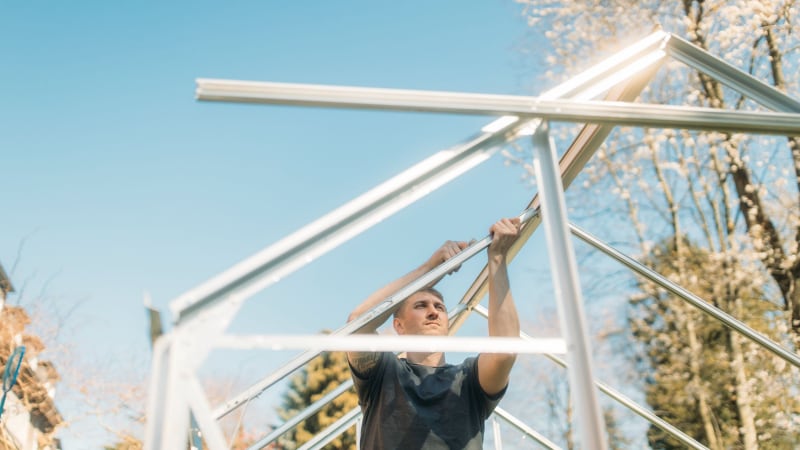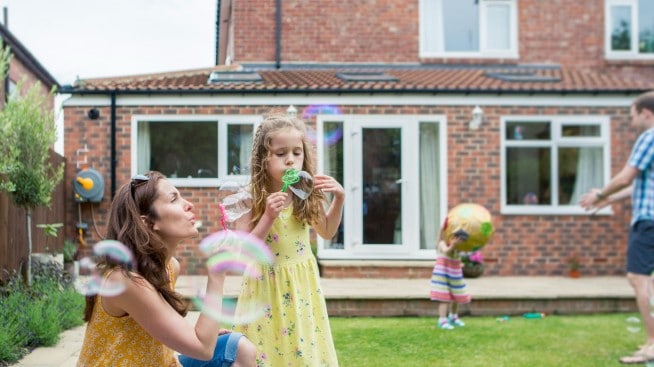Energy-efficient homes: A guide to going greener

Energy-efficient homes are about more than just saving the environment. These homes take advantage of innovative designs, intelligent resource consumption and modern appliances to minimize energy use and potentially lower your routine energy bills, too. The result is, ideally, a comfortable living space that’s gentle on both your wallet and the planet. Let’s explore energy efficiency and discover how to make your home greener, one watt at a time.
What is energy efficiency?
You’ve probably heard the term, “energy-efficient” tossed around before. You likely guessed correctly that it has something to do with reducing power and resource consumption. But what does energy efficiency mean at home?
Energy efficiency means optimizing the way your house consumes energy, which can help lower your living costs and reduce your environmental footprint. Energy-efficient homes use less energy to perform the same tasks as a regular home, usually without compromising comfort or convenience. They’re often designed and constructed to make the most of the natural resources used, which may also save on potential construction costs.
Environmental benefits of energy-efficient homes
Building an energy-efficient home potentially does more than just save you money — it may also reduce your footprint and strain on natural resources. Here‘s how:
Reduced carbon footprint
Energy-efficient homes help reduce your carbon footprint by lowering your energy consumption. Energy-efficient appliances, smart insulation and energy-efficient home design all help decrease the amount of energy your home draws. Since many power plants burn fossil fuels like coal and gas, this reduction in energy usage may directly correspond to fewer greenhouse gas emissions.
Conservation of resources
An energy-efficient home isn’t just beneficial for its own inhabitants — it’s also gentler on key resources. Take, for instance, the use of sustainable or recycled building materials in construction. By choosing reclaimed wood for flooring or recycled steel for framing, we might minimize the demand for new resources and help reduce waste. Further, energy-efficient appliances like low-flow showerheads and dual-flush toilets can potentially reduce household water use.
Conscious choices like these, among others, demonstrate how energy-efficient homes might contribute to a broader ethos of resource conservation and sustainability.
Building an energy-efficient home
If you have the resources and are interested in maximizing the benefits of energy-efficient house design, you could consider starting from the ground up and building a home. Building an energy-efficient home from scratch lets you infuse every aspect of your home’s design with energy-saving solutions, from its positioning to its building materials and more. Here are some key principles to keep in mind during the blueprint stage:
Design with nature in mind
Taking advantage of natural sunlight is a simple way to improve energy efficiency. Properly oriented windows and skylights can help reduce your dependence on both artificial lighting and heating, potentially making for considerable energy savings.
Innovative insulation
When building an energy-efficient home, you may want to extend your insulation beyond the usual suspects. Consider insulating often-overlooked areas like floors and crawlspaces and opting for energy-efficient windows and doors. Another thing to look out for is “thermal bridges” — spaces where heat escapes through less-insulated sections of walls, often around windows and doors or where the wall meets the floor or ceiling.
Energy-efficient systems
Beyond just opting for newer appliances, choosing energy-efficient heating, ventilation and air conditioning (HVAC) systems and water heaters from the outset could give your home the energy-efficient “engine” needed to make the most of your wattage from the get-go.
Optimal ventilation
Another key principle to energy-efficient home design is proper ventilation. A well-ventilated house can reduce the need for artificial heating or cooling by allowing fresh outdoor air to replace indoor air, controlling humidity and maintaining moderate indoor temperatures — thereby conserving energy.
Devices such as energy recovery ventilators (ERVs) can help maintain this balance by transferring heat and moisture from incoming and outgoing air streams. For example, in colder months, ERVs recover heat from exhaust air and transfer it to incoming fresh air, reducing the need for artificial heating. Conversely, during warm seasons, ERVs extract heat from incoming air, essentially “pre-cooling” it to reduce load on air conditioning.
How to make your home more energy-efficient
Maybe you live in a property with more history, built before energy consumption was a concern. Just because your home wasn’t built with energy efficiency in mind, however, doesn’t mean you can’t reap the rewards of energy efficiency. Here are a few ideas on how to make your home more energy-efficient:
Insulation
Insulation is the cornerstone of an energy-efficient home. Proper insulation helps maintain the desired temperature for longer, reducing the demand on your heating and cooling systems. You might want to look at improving your wall and attic insulation, as well as ensuring your windows and doors are properly sealed to minimize energy loss.
Smart heating and cooling
Speaking of energy lost during heating and cooling, you might want to rethink how you heat and cool your home in the first place. Smart devices may come with features that help you optimize your energy use to get the most bang for your buck. A programmable thermostat, for example, can automatically adjust the temperature based on your routines, working to ensure energy isn’t wasted on heating or cooling when nobody’s home.
Energy-efficient appliances
Switching to energy-efficient appliances can make a surprising difference, as older models might be consuming more energy than you realize. In fact, modern energy-efficient appliances typically do the same job just as well, if not better, with less energy.
In summary
Energy-efficient homes offer residents the prospect of lower energy bills, a reduced carbon footprint and, oftentimes, enhanced comfort. Whether you’re retrofitting your current home or building an energy-efficient home from scratch, embracing energy efficiency is a valuable step towards greener living. Perhaps now is the perfect moment to consider what an energy-efficient future might look for you.



